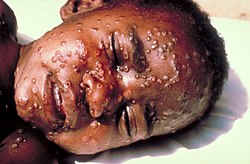Smallpox
From WikiLectures
The variola virus is a dsDNA virus of the poxviridae family, it is the cause of smallpox. Humans are the only natural host of Orthopoxvirus, resulting in the eradication of smallpox in 1977. Vaccination is therefore no longer performed. The incubation period was 10-12 days[1].
- Two forms:
- variola major (lethality 15–40 %)[1];
- variola minor – less severe symptoms and lower lethality.
Pathogenesis[edit | edit source]
- Spread of the virus by droplet infection, direct contact, or air (dust from dried scabs).
- Entry into the body through the respiratory tract and subsequent multiplication.
- Phagocytosis of the microorganism and hematogenous spread to the skin, mucous membranes, and internal organs, where it causes cell destruction.
- Manifestations: blisters on the mucous membranes and skin, papules, pustules, fever, bleeding into the skin and organs, ulceration on the mucosa.
- Danger of bacterial contamination – purulent deposits.
Diagnostics[edit | edit source]
- Using an electron microscope – detection of viral particles in the blister fluid.
- Direct immunofluorescence.
- PCR
- Finding cytoplasmic inclusions "Guarnier bodies".
- Detection of specific antibodies.
Therapy[edit | edit source]
- Marboran.
- Immunization with a live viral vaccine.
Epidemiology[edit | edit source]
The only source of the virus is humans, another host is not known in nature. Prevention by vaccination with a similar strain is no longer practiced.
Links[edit | edit source]
Related Articles[edit | edit source]
Used Literature[edit | edit source]
- HORÁČEK, Jiří. Základy lékařské mikrobiologie. 1. edition. 2000. vol. 1. ISBN 80-246-0006-4.
- BEDNÁŘ, Marek. Lékařská mikrobiologie : bakteriologie, virologie, parazitologie. 1. edition. 1996. vol. 558. ISBN 8023802976.
References[edit | edit source]
- ↑ Jump up to: a b BEDNÁŘ, Marek – SOUČEK, Andrej – FRAŇKOVÁ, Věra. Lékařská mikrobiologie : Bakteriologie, virologie, parazitologie. 1. edition. 1999. vol. 558. pp. 356–357. ISBN 8023802976.




